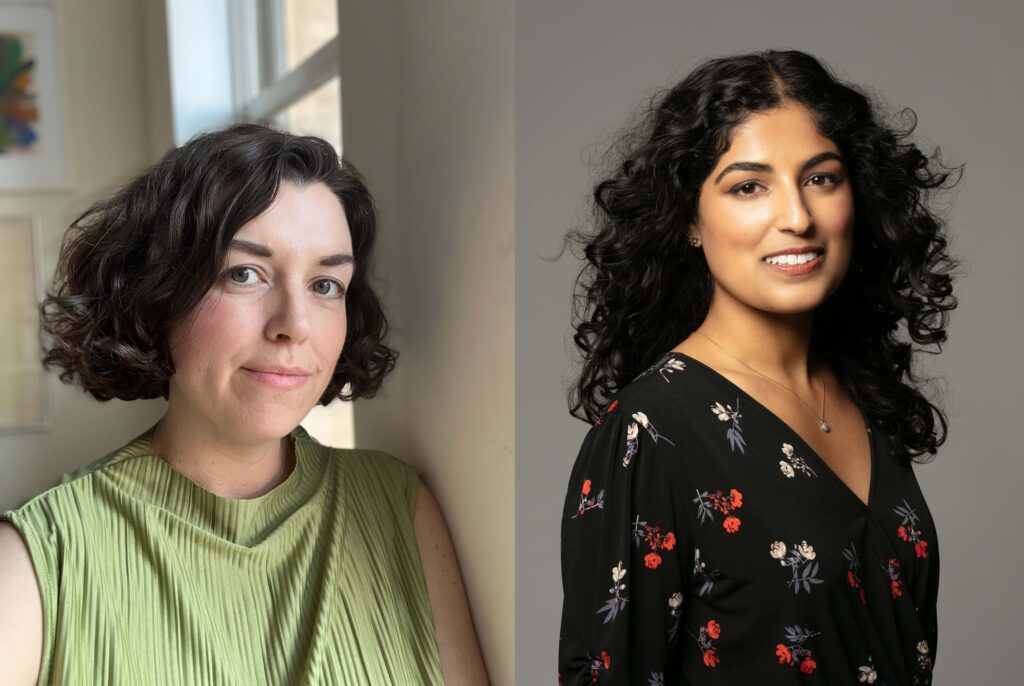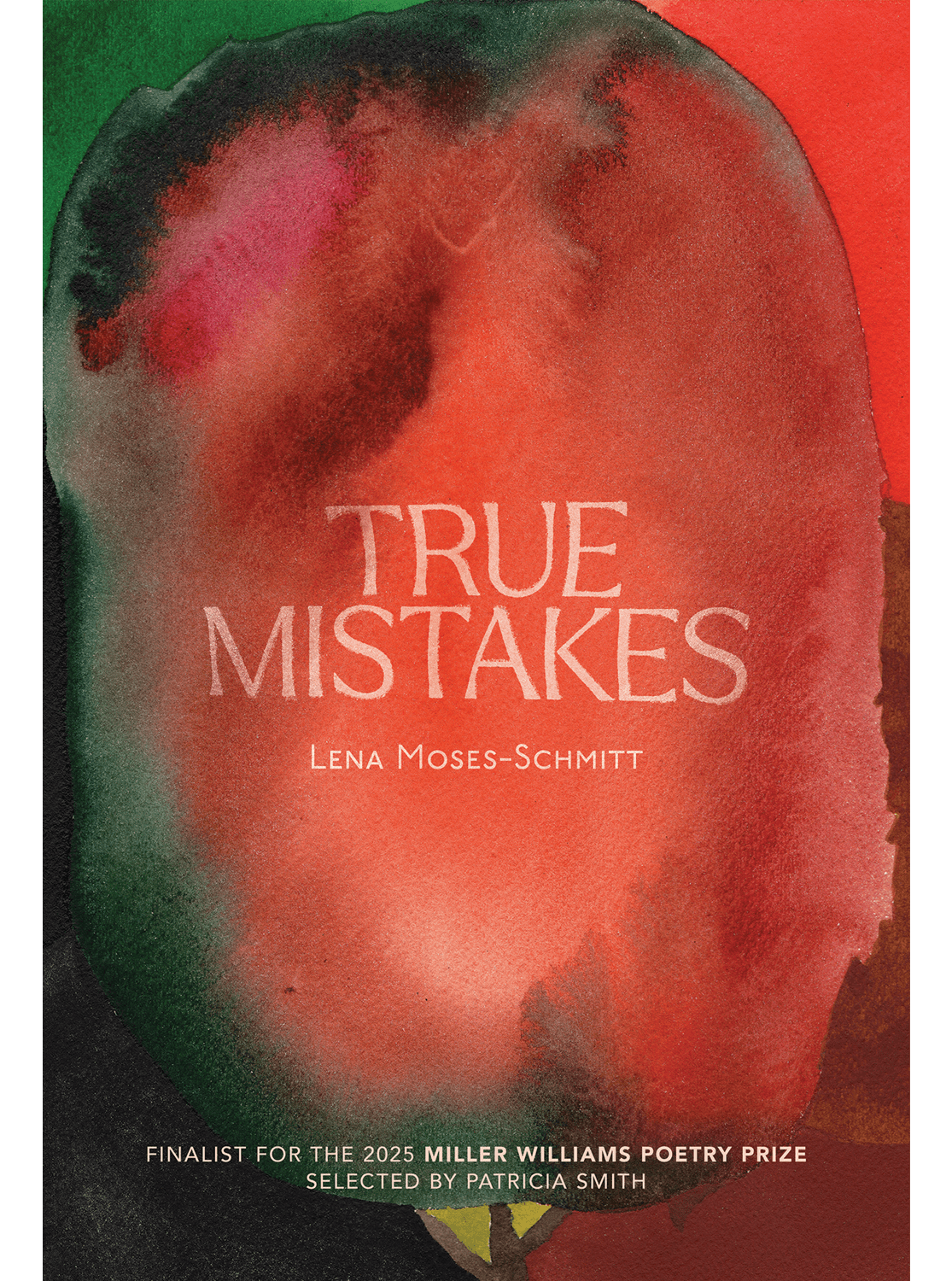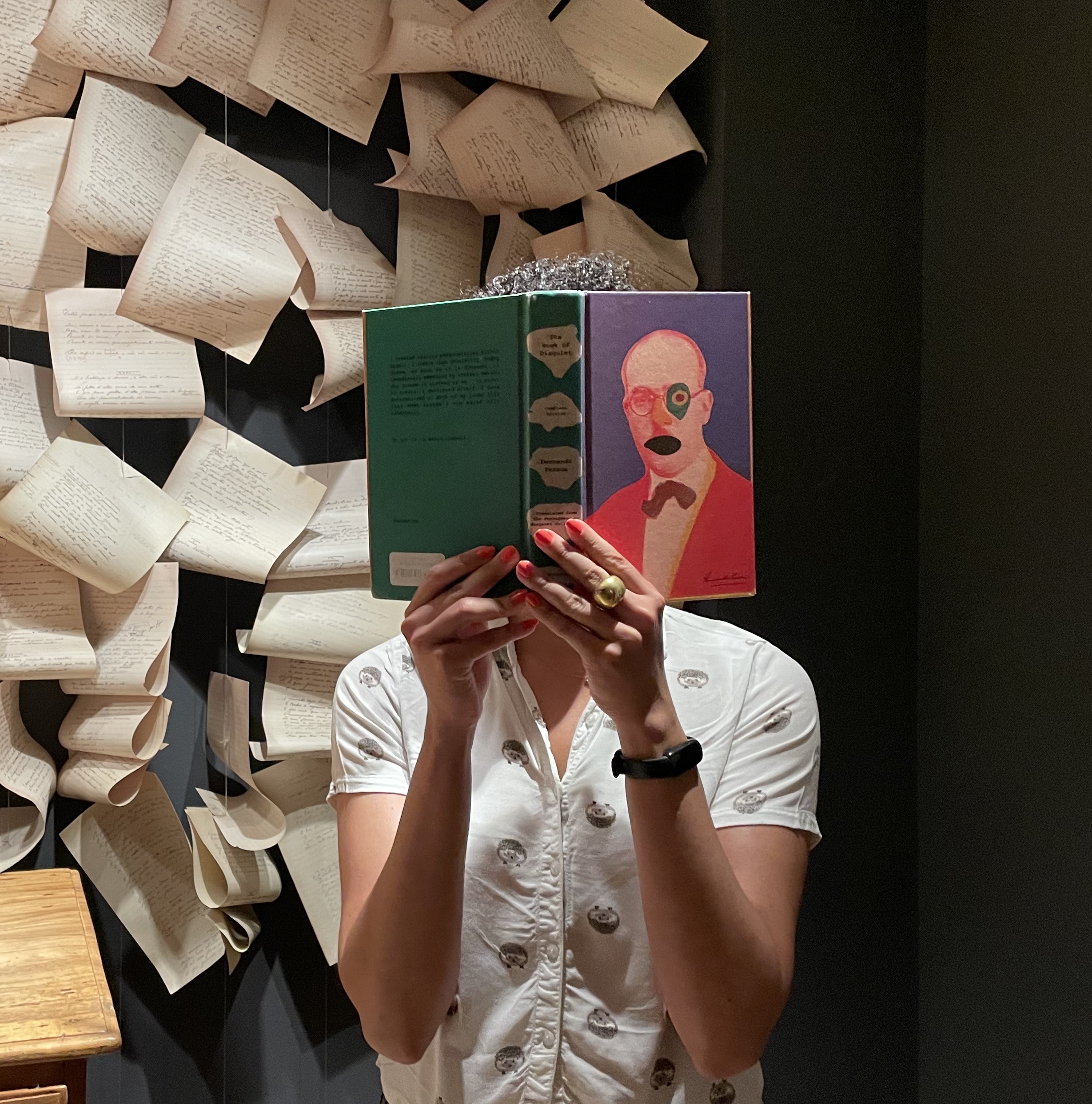
Lena Moses-Schmitt (left) and Megan Pinto (right)
When we listen to language, what do we hear? When we look at an image, what do we see? LENA MOSES-SCHMITT’s poetry beautifully captures the nature of perception. Her lyric-narrative meditations are interested in the mind’s movement across the field (visual, sonic) and the page. Moses-Schmitt writes in “The Hill”: “This morning I heard the man/ who lives downstairs say I love you to the woman–/not the words, but the rhythm, the shape, and I filled in the rest/ as if with red crayon.” Her debut collection, True Mistakes, moves between perception and imagination, the grieving for and the making of a life. MEGAN PINTO sat down with Lena Moses-Schmitt on a sunny June afternoon in Brooklyn. They marveled at the light through the leaves and drank cold seltzers with bitters. Their conversation shifted from superhero alter egos to how poetry sustains them through life’s many blips and heartbreaks.
Megan Pinto (MP): If you were a superhero, what would your primary and secondary superpowers be? And your Achilles heel? Because you can’t be perfect.
Lena Moses-Schmitt (LMS): My primary would be flying, which is a boring answer, but obviously.
MP: Obviously!
LMS: What is yours?
MP: Flying as well and teleporting. It’s something I’ve always wanted to do, but it might not be good for you psychically, because it could erode your sense of distance.
LMS: When I was younger, I had fantasies of being invisible. But now I don’t want to disappear. I want to be seen.
MP: That’s beautiful. What’s your Achilles heel?
LMS: Oh God. I think my Achilles heel is my physical body, not being able to do all the things I want to do at the pace I want to do them.
MP: Mine is enthusiasm. I get an idea, and I’m like, that’s brilliant, I should do that! And then I take three steps and am like “Oh no, what have I done?”
LMS: This is a great way to enter into the writing process conversation. Our superhero powers are so tied to process and how we imagine ourselves.
MP: When you’re trying to do something that feels impossible, like finishing a book while working full-time, it helps to think, “What powers am I drawing on today?”
Speaking of process, you also draw and paint. What is your relationship to returning to the page? Do you have practices or routines that bring you back to writing?
LMS: Because making different kinds of art is so central to my life in all these ways, I’ve had to get flexible about how I return to the page. And I think flexibility is the key word. I used to have a lot of guilt when I wouldn’t write for long periods. But more and more now I try to trust that the work is still happening, even when I’m not writing. So sometimes that means I’m writing in my head or taking notes on my phone while I’m walking around or commuting. Sometimes that means I’m painting, and that helps me lead me into the poems. I try not to shame myself when I’m not writing. I used to feel like I wasn’t a writer if I wasn’t writing all the time. And now I think I’m more interested in making space for the conditions that allow me to write rather than forcing the writing itself.
Sometimes that just means like reading a really good poem and being like, “Oh! I remember now.” Something clicks into place. Or taking a break to watch a movie or see friends, or just live life. All of that can be part of the process too, actually, it has to be.
MP: While working full-time and trying to write my book, I had to change how I thought about writing. It wasn’t always sitting down for three hours and writing a poem. Sometimes it was just jotting a note, or even going on a walk and saying a line out loud and recording it on my phone. And then later recognizing, “Oh, that was a line.” That was a gesture I could follow. I feel like we’re constantly gathering, and then at some point we sit down and make meaning.
LMS: It’s funny how sometimes those little notes or moments become the center of something. You don’t realize how important they are at the time.
MP: Yes. You’re not failing if you’re not producing a finished piece right now. You might just be listening.
LMS: And I think that’s part of what we were talking about earlier. Sometimes it takes time to be able to write into something. And before that, maybe you’re just living it.
Sometimes we’re too quick to try to make meaning. But some things just need to be held first. Or acknowledged. I feel like poems are really good at that—at holding what’s hard to hold.”
MP: You’ve written so beautifully about grief. And I’m curious how you approach writing about something that’s still tender or raw. Do you wait until you have some distance? Or do you write from within it?
LMS: I think I do both. Sometimes I write right in the middle of the feeling, and sometimes I need space. There’s a kind of writing that happens when I’m deep in it that’s very fragmented or maybe even incoherent. But later, I can return to those fragments and shape them into something. When I’m in it, I don’t always know what I’m saying. But the act of writing is still important—it’s like marking something. And then later, when I have more perspective or more language, I can come back and make sense of it. Sometimes we’re too quick to try to make meaning. But some things just need to be held first. Or acknowledged. I feel like poems are really good at that—at holding what’s hard to hold. They don’t require resolution in the same way prose sometimes does. When you write from grief, you’re often trying to touch something that can’t be resolved. So the openness of the poem is really important.
MP: I’m thinking, too, about how process and grief intersect. Both require patience and care. And how we’re not always taught that in workshop spaces.
LMS: Definitely. So many workshop spaces are focused on product. Like, is this poem working? Is this poem done? But sometimes the more interesting question is: what is this poem trying to do?
MP: Yes. Or what does this poem want to be?
LMS: Exactly. I think when I’m grieving—or even when I’m not—one of the most helpful things is just asking: what does this piece want? Not what do I want it to be, but what does it want to become? And hopefully I can get out of the way a little.
MP: That’s such a generous way to approach your work.
LMS: It just takes the pressure off, to not try to force the poem into a shape it doesn’t want. I’m just listening.
The mystery is part of what makes poems powerful. They can say something you didn’t know you needed to hear—even if it’s something you don’t quite understand, but keeps drawing you back in.”
MP: Do painting and visual art shape how you think about poetic form?
LMS: I think so. I feel like I think in images and language equally. A lot of the time, the poem starts with a visual. Or with color. Or with a sense of space. And I think making visual art has taught me to trust the nonlinear—to trust juxtaposition and layering and gesture. And that definitely carries into my writing. Like, I’m less concerned with narrative or logic and more interested in feeling, texture, resonance.
MP: That’s so clear in your work. Your poems are incredibly spacious—they hold so much emotion, but they also leave room for the reader.
LMS: Thank you. That means a lot. I think I’m always trying to strike a balance between intimacy and openness. How do I invite someone in without overwhelming them? That’s something I’m always navigating. Sometimes explanations can flatten a poem. If I try to overdetermine the meaning, I lose something. The mystery is part of what makes poems powerful. They can say something you didn’t know you needed to hear—even if it’s something you don’t quite understand, but keeps drawing you back in.
MP: I remember reading your exchange with Martha Park in Lit Hub where you talked about your “Dear Future Me” series as being written at this point of personal and also national crisis in terms of COVID . To write these, you created this kind of formal constraint of the “Dear Future Me” as an epistolary. I’m curious how you think of that sequence in relation to perception—I think so much in your work has to do with perception: how we are seeing what our eyes are cast upon? Are we seeing what we want to see? I’m curious about that. And this idea of creating a “vision” for a future self.
LMS: That’s such an astute question. I haven’t totally thought about the future poems in terms of perception, but you’re right: they’re a completely different kind of seeing because they’re trying to perceive something, or someone, that’s not there. Though there’s a lot of cursory level “seeing” throughout—like the poems are using literal image and the concrete visual details of life.
MP: Right, and thinking of those poems in the context of the book, the rest of the poems are so grounded in perception, for example, the poem where the speaker draws her lover and is asking, “Is it him that I’m seeing, or is it myself?” “Who is he?” “What do I see?” So much of the book asks those sorts of questions. The “Dear Future Me” poems are doing something slightly different, where they’re trying to see a version of yourself in the future and making sure that she exists. But I don’t think they’re concerned with asking who this person is in the future? They’re more just like, “Okay, I’m writing to you. And I’m hoping that you’re there.”
LMS: When I wrote those, I was pretty depressed, very anxious, and constantly in a state of despair and dread, both in my life and also over the world in general. It was a time when I questioned if a future was going to exist, and what that future would mean or look like. I wanted to write to my future self to make her, and the future in general, real. And many of the poems contain details about what I did that day, that week. I think I was writing those poems, ironically, as a way to stay in the present and find it bearable. But you’re right, they’re not concerned with who that person is, or with an “aspirational” future self—the speaker just wants to know that her presence is there. And the very act of writing them created that presence, that force, of the future self.
Megan: I want to talk about movement. There’s a lot of movement on the page, like many of your poems take on this shape where they’re moving back and forth, left and right, almost in a loose zigzag. There’s like a departure from the left margin. You’ve talked about long walks as part of your process. And also, I remember you saying something about departing from the left margin…
LMS: Yeah, this was something I heard Richard Siken say in an interview—I think on the Commonplace podcast. He said something about how the left margin is gravity, and any departure from that margin is basically a leap away from gravity, and the poem can’t help but come back down to earth again. Many of my more recent poems are entirely left justified, but when I heard that interview, I was writing a lot of poems with lines indented all over the page, and when I heard Richard Siken say that, I immediately connected that practice with my teenage years as an ice skater.
MP: And you’re also interested in this idea of movement influencing thought, because the speaker in the poems is often moving, too. Or if the speaker’s still, then something is moving around the speaker.
It’s the flow state. It’s a way of getting your consciousness out of your mind and into the body where it feels more primal.”
LMS: Well, movement is action. And if I’m interested in exploring thought as a subject, then there’s automatically a dilemma because thought doesn’t necessarily look like anything. Like, if you’re looking at somebody thinking or staring out a window, it doesn’t appear as if anything is happening. I think sometimes movement can be used to show how thought is made manifest outside the body.
And also just more generally: when you leave the house, when you are walking, your thoughts change because your environment changes, and your body is changing. Moving is a way of your consciousness interacting with the world, or paying attention to how the two interact.
I don’t ice skate much anymore. But for about the last seven or eight years, I’ve taken a lot of dance classes, and dancing has been really important to me. What I find so interesting in those classes is that I barely think at all, at least when it’s going well. It’s amazing. My body becomes more conscious than my mind.
MP: That’s also how you sometimes talk about drawing and painting.
LMS: It’s the flow state. It’s a way of getting your consciousness out of your mind and into the body where it feels more primal.
And so using the whole page in a poem, and not just using the left margin, is a way of giving the poem a body, giving thought a body.
MP: When we’re talking about thought in a poem, or thoughts, we’re talking about language-based thoughts, because I think there are many kinds of intelligence. And we’re talking about bodily intelligence, kinesthetic intelligence. But if we’re if we’re only living in the world of language-based thinking, language is inherently a human-constructed and limited system of symbols, and what I’m hearing you say is that by departing from the left margin, giving the poem movement is like a kinesthetic thought. It encompasses other parts of feeling that we can’t quite capture in language. I completely agree.
LMS: I also find that movement stimulates verbal thought—if I’m stuck and I take a walk, or even if I get up to get water or something, an idea for the next line often comes to me. It’s so magical— the intelligence of the body.
MP: You know a lot of my poems, I also write or revise while walking, and I just carry it with me. Or I have a notebook that I bring everywhere. I do a lot of writing in my notebook, on the go. I also love writing on the subway.
LMS: See, that is something I haven’t really done yet.
MP: It’s like a little poetry laboratory.
I’m curious—when you’re writing, do you have any rituals or things that help you drop into that intuitive space?
LMS: That’s such a good question. I think it changes, honestly. But often, I’ll light a candle or drink coffee. Tea at night. I like to read before I write, just to get into the rhythm of language; reading often makes me want to sit down and write. And I try not to check my phone, of course. Lately I’ve enjoyed letting myself zone out for a bit before starting to write—just sitting and breathing and looking around. But just creating a small ritual or threshold helps me shift into a different mode. It doesn’t have to be dramatic, but it helps me feel like, okay, now I’m entering this space.
MP: I love that idea of a threshold. Writing is such a vulnerable act, and having a ritual helps make it feel safer.
LMS: Yes, exactly. It’s like telling myself, You’re allowed to be here now.
MP: I think I used to believe I needed ideal conditions to write—a cabin in the woods, uninterrupted time—but now I know that a small gesture can be enough. A cup of tea, a five-minute pause.
LMS: And sometimes those constraints even help. When I know I only have an hour or even ten minutes before work, I might write something I wouldn’t if I had all day. There’s a kind of urgency or clarity that comes.
MP: Yes. And I think that’s where our superhero powers come in—finding creative ways to show up, even in small ways, and trusting that it matters.
LMS: Absolutely. I think honoring whatever we’re able to do, however small, is part of sustaining a creative life.
Lena Moses-Schmitt is a writer and artist. She is the author of the poetry collection True Mistakes, which was selected by Patricia Smith for the Miller Williams Poetry Series. Her poems, essays, and graphic essays appear in Best New Poets, The Believer, Ecotone, The Rumpus, Narrative, The Yale Review, The Slowdown Podcast, and elsewhere. She currently lives in New York.
Megan Pinto is the author of Saints of Little Faith and the chaplet Lovesick. Megan’s poems can be found in Los Angeles Review of Books, Poets.org, Ploughshares, the Slowdown Podcast, and elsewhere. She lives in Brooklyn.



